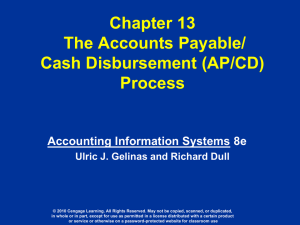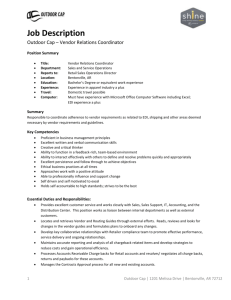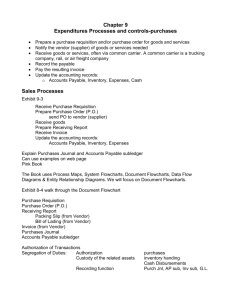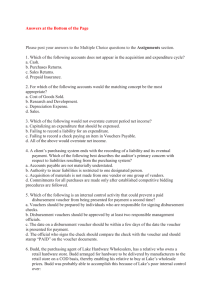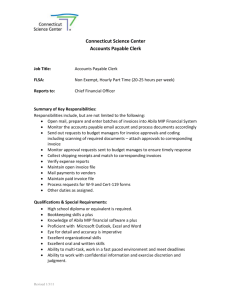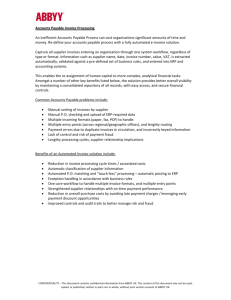Chapter 12
advertisement
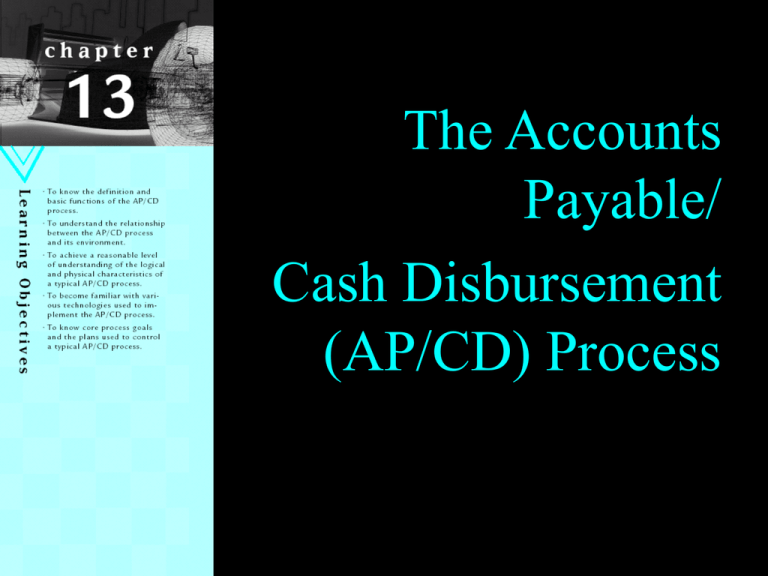
The Accounts Payable/ Cash Disbursement (AP/CD) Process 1 Learning Objectives • Know definitions and basic functions of the AP/CD process • Understand relationship between the AP/CD process and its environment • Achieve a reasonable level of understanding of the logical and physical characteristics of typical AP/CD process • Become familiar with various technologies used to implement the AP/CD process • Know core process goals and the plans used to control a typical AP/CD process AP/CD AP/CD on the AIS Wheel • In this chapter, we spotlight one business process, the accounts payable/cash disbursements (AP/CD) process and explore the processes, systems, and controls that should be in place to ensure that the accounts payable/cash disbursement process operates efficiently and effectively. • Additionally, we will examine specific process control procedures that help ensure all accounts payable are paid in a timely fashion. 3 Process Definitions and Functions • The accounts payable/cash disbursements (AP/CD) process is an interacting structure of people, equipment, methods, and controls that is designed to accomplish the following primary functions: 1. Handle the repetitive work routines of the accounts payable department and the cashier 2. Support the decision needs of those who manage the accounts payable department and cashier 3. Assist in the preparation of internal and external reports 4 AP/CD Horizontal Perspective 1. Invoice Received from vendor 5 AP/CD Horizontal Perspective 2. Approved voucher sent to cashier 6 AP/CD Horizontal Perspective 3. Accounts payable notification sent to general ledger process 7 AP/CD Horizontal Perspective 4. Check sent from cashier to vendor 8 AP/CD Horizontal Perspective 5. Paid voucher returned to the AP department 9 AP/CD Horizontal Perspective 6. Notification of the cash disbursement sent from the cashier to the general ledger process 10 Vertical perspective-AP/CD 11 The AP/CD Process—Level 0 Diagram 12 AP/CD Process Level 1 DFD: Validate Invoice (Assumes non-voucher system—a formal voucher would have space for formal approval and account distribution) 13 AP/CD Process Level 1 DFD: Make Payment (Triggered by due date of invoice) 14 Purchase Returns and Allowances • In some cases defective goods may be returned or an allowance made for nonconforming items – This exception routine usually begins at the point of inspecting and counting the goods or at the point of validating vendor invoices – Purchaser transmits a debit memo to the vendor requesting the account adjustment – The vendor responds with a credit memo indicating the authorized account adjustment 15 Processing Non-Invoiced Disbursements • In some cases disbursements are not invoiced, e.g., freight bills, rent, payroll, etc. • The handling of non-invoiced disbursements depends on whether or not a voucher system is used • A voucher system prepares a voucher for every expenditure from payroll to purchases of raw materials 16 Processing NonInvoiced Disbursements 17 Logical Data Descriptions for the AP/CD Process • Accounts payable master data. This data store is a repository of all unpaid vendor invoices – The data design should consider how the data will be processed when the cash manager is deciding what payments to make – For example, the manager may want to merge vendor invoices so that the total amount due each vendor can be accumulated – Alternatively, the manager might want to select specific invoices for payment • Cash disbursements data. The purpose of this data is to show, in chronological sequence, the details of each cash payment made. – Each record in this data normally shows the date the payment is recorded, vendor identification, disbursement voucher number (if a voucher process is used), vendor invoice number and gross invoice amount, cash discount taken on each invoice, net invoice amount, check amount, and check number. 18 EntityRelationship (E-R) Diagram (Partial) for the AP/CD Process 19 Technology Trends and Developments • The AP/CD process is the primary candidate for EDI in major organizations (as it is in the OE/S, B/AR/CR, and purchasing processes as well) • Several major companies have implemented EDI systems into the AP/CD process, resulting in significant cost savings – An increasing trend among some of these major companies is to require all vendors to use EDI in their transactions with the company – If the vendor does not implement EDI technologies, the major companies simply find a new supplier • In the last few years, several alternatives to EDI have been deployed – These new technologies, based, for example, on XML or IP-based EDI (Internet EDI), have not replaced EDI – Services provided by the value-added networks (VANs) and the high degree of EDI standardization make EDI attractive for fully digital B2B collaboration among trading partners for years to come • Many organizations are using Web-based payment systems 20 AP/CD Process: Systems Flowchart 21 AP/CD Fraud • AP fraud usually involve fictitious vendors and false invoices – A dishonest employee who has access to the vendor file and authorizes payment – May embezzle amounts refunded by vendors – Human error is still a leading cause of loss • CD fraud is less sophisticated – Usually involves check fraud – Check fraud takes many forms from stealing and passing stolen checks to changing amounts on legitimate checks or check forgery – CD fraud is becoming easier and more common with computer duplication technology 22 Exposure to Loss and Destruction of Resources • Although the subject of fraud and embezzlement is seductively interesting, resource losses due to unintentional mistakes and inadvertent errors are as costly as, or more costly than those caused by intentional acts of malfeasance – Making payments for incorrect or larger amounts – Paying the wrong vendor – Paying the same invoice twice 23 AP/CD Fraud • AP fraud usually involve fictitious vendors and false invoices – A dishonest employee who has access to the vendor file and authorizes payment – May embezzle amounts refunded by vendors – Human error is still a leading cause of loss • CD fraud is less sophisticated – Usually involves check fraud – Check fraud takes many forms from stealing and passing stolen checks to changing amounts on legitimate checks – CD fraud is becoming easier and more common with computer duplication technology 24 AP/CD Control Matrix 25
